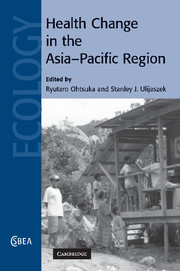Book contents
- Frontmatter
- Contents
- List of contributors
- Acknowledgements
- 1 Health change in the Asia-Pacific region: disparate end-points?
- 2 Interactions of nutrition, genetics and infectious disease in the Pacific: implications for prehistoric migrations
- 3 Biocultural adaptation and population connectedness in the Asia-Pacific region
- 4 Changing nutritional health in South East Asia
- 5 Obesity and nutritional health in Hong Kong Chinese people
- 6 Modernization, nutritional adaptability and health in Papua New Guinea Highlanders and Solomon Islanders
- 7 Tongan obesity: causes and consequences
- 8 Nutrition and health in modernizing Samoans: temporal trends and adaptive perspectives
- 9 Health patterns of Pacific Islanders and Asians in the United States
- 10 Impacts of modernization and transnationalism on nutritional health of Cook Islanders
- 11 Mortality decline in the Pacific: economic development and other explanations
- 12 Health changes in Papua New Guinea: from adaptation to double jeopardy?
- Index
- References
11 - Mortality decline in the Pacific: economic development and other explanations
Published online by Cambridge University Press: 15 September 2009
- Frontmatter
- Contents
- List of contributors
- Acknowledgements
- 1 Health change in the Asia-Pacific region: disparate end-points?
- 2 Interactions of nutrition, genetics and infectious disease in the Pacific: implications for prehistoric migrations
- 3 Biocultural adaptation and population connectedness in the Asia-Pacific region
- 4 Changing nutritional health in South East Asia
- 5 Obesity and nutritional health in Hong Kong Chinese people
- 6 Modernization, nutritional adaptability and health in Papua New Guinea Highlanders and Solomon Islanders
- 7 Tongan obesity: causes and consequences
- 8 Nutrition and health in modernizing Samoans: temporal trends and adaptive perspectives
- 9 Health patterns of Pacific Islanders and Asians in the United States
- 10 Impacts of modernization and transnationalism on nutritional health of Cook Islanders
- 11 Mortality decline in the Pacific: economic development and other explanations
- 12 Health changes in Papua New Guinea: from adaptation to double jeopardy?
- Index
- References
Summary
Introduction
The history of human mortality in the Pacific is one of peaks, troughs and contrasts. When James Cook first sailed to this part of the world in 1769, he commented on the vigour and good health of the peoples he met. Indeed, the evidence we now have suggests that Pacific Islanders of the time probably lived, on average, at least as long as their contemporaries in England. But mortality rates climbed steeply among indigenous populations following colonization, while European settlers in Australia and New Zealand were for a time the longest-lived people anywhere in the world. In the recent period, mortality rates have continued to fall in Australia and New Zealand, but again, the experience of indigenous and non-indigenous populations has not been the same. In this chapter, we describe the major patterns of mortality in the Pacific and review possible causes, concentrating especially on the role of economic development. We will focus most closely on recent changes in mortality in New Zealand, including the experience of Maori and Pacific peoples, and contrasts in mortality patterns between populations in New Zealand and Australia.
The longest-lived people in the world in 1840, when reliable national death statistics were first available, were Swedish women, whose life expectancy at birth (LEB) was about 45 years. Some 160 years later, maximum LEB is almost double that value (in 2002, Japanese women could expect to live on average for 85 years) (Oeppen and Vaupel 2002).
- Type
- Chapter
- Information
- Health Change in the Asia-Pacific Region , pp. 234 - 253Publisher: Cambridge University PressPrint publication year: 2007

